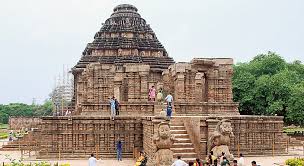Relevance: Prelims/Mains: G.S paper I: Indian Art and Architecture
Why in news?
- A plan to restore and preserve the nearly 800-year-old Konark Sun Temple in Odisha would be drawn up soon, after a two-day conference of experts at the end of the month.
UNESCO site:
- The 13th Century temple, which is a UNESCO World Heritage Site, had been filled with sand and sealed by the British authorities in 1903 in order to stabilise the structure.
- A scientific study was carried out by the Roorkee-based Central Building Research Institute from 2013 till 2018 to ascertain the temple’s structural stability as well as the status of the filled-in sand.
- The official said the study found that the sand filled in over 100 years ago had settled, leading to a gap of about 17 feet. The official, however, added that the structure was found to be stable.
- The ASI was in the process of removing the scaffolding erected.
Dedicated to the Hindu Sun God Surya, what remains of the temple complex has the appearance of a 100-foot (30 m) high chariot with immense wheels and horses, all carved from stone.
Once over 200 feet (61 m) high, much of the temple is now in ruins, in particular the large shikara tower over the sanctuary; at one time this rose much higher than the mandapa that remains.
The structures and elements that have survived are famed for their intricate artwork, iconography, and themes, including erotic kama and mithuna scenes. Also called the Surya Devalaya, it is a classic illustration of the Odisha style of Architecture or Kalinga Architecture.
The cause of the destruction of the Konark temple is unclear and remains a source of controversy.
Theories range from natural damage to deliberate destruction of the temple in the course of being sacked several times by Muslim armies between the 15th and 17th centuries.
This temple was called the “Black Pagoda” in European sailor accounts as early as 1676 because its great tower appeared black.
Similarly, the Jagannath Temple in Puri was called the “White Pagoda”. Both temples served as important landmarks for sailors in the Bay of Bengal.
The temple that exists today was partially restored by the conservation efforts of British India-era archaeological teams. Declared a UNESCO world heritage site in 1984, it remains a major pilgrimage site for Hindus, who gather here every year for the Chandrabhaga Mela around the month of February


